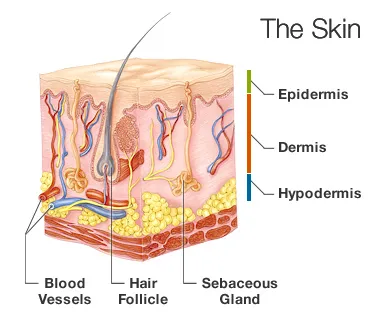Your skin is the largest organ on your body, made up of several different components, including water, protein, lipids, and different minerals and chemicals. If you're average, your skin weighs about six pounds. It's job is crucial: to protect you from infections and germs. Throughout your life, your skin will change constantly, for better or worse. In fact, your skin will regenerate itself approximately every 27 days. Proper skin care is essential to maintaining the health and vitality of this protective organ.

How Can I Keep Skin Healthy?
- Thorough cleansing. You should perform this twice daily. At night, make sure you remove all your make-up and cleanse properly before going to bed.
- Use a gentle soap without fragrance.
- Balanced nutrition.
- Moisturizing. This is recommended even for those who have oily skin. There are plenty of moisturizers on the market that are oil-free.
- Sunscreen. This is probably the most important thing that you can do for your skin. Even in the winter and on cloudy days, you should put sunscreen on every day. This should be done even if you are not outside much. A sunscreen that says “broad spectrum” (or says it protects against “UVA and UVB”) with an SPF of 30 or higher is necessary. Limiting your time in the sun, especially between the hours of 10 a.m. and 2 p.m., and wearing protective clothing, such as a long-sleeved shirt, pants, and a wide-brimmed hat, are also recommended.
Over the course of your life, you should pay attention to all parts of your skin. Familiarize yourself with it, so you'll notice any changes that might occur, such as different moles or patches that might indicate skin cancer. Whenever you have a question or concern, make sure you see your doctor.
How Does My Skin Work?
There are medical terms for various parts of your skin. Here's a rough guide to what those terms mean.
Stratum corneum: The Outer Layer of Dead Skin
The stratum corneum contains dead skin cells that used to exist in the epidermis. Using facial scrubs and some other skin products will remove or thin this layer.
Epidermis: The Outer Layer of Skin
The epidermis is the thinnest layer in your skin, but it's responsible for protecting you from the harsh environment. The epidermis has four layers of its own: stratum germinativum, stratum spinosum, stratum granulosum, and stratum lucidum. The epidermis also hosts different types of cells: keratinocytes, melanocytes and Langerhans cells. Keratinocytes produce the protein known as keratin, the main component of the epidermis. Melanocytes produce your skin pigment, known as melanin. Langerhans cells prevent foreign substances from getting into your skin.
Dermis: The Middle Layer of Skin
This is the layer responsible for wrinkles. The dermis is a complex combination of blood vessels, hair follicles, and sebaceous (oil) glands. Here, you'll find collagen and elastin, two proteins necessary for skin health because they offer support and elasticity. Fibroblasts are the cells you'll find in this layer, because they synthesize collagen and elastin. This layer also contains nerves that sense pain, touch, and temperature.
Thanks so much for the work you have put into this post. I have this post bookmarked in Delicious and will refer back frequently over the next several day.
ReplyDeleteallah barkat locket
Wonder Shapers
Dhanlaxmi Yantra
Body Buildo
Step Up Height Increaser
Air Bra
Hanuman Chalisa Yantra
Body Buildo
Fair Look
Slim Pro
Sandhi Sudha
Hot Shapers
Step Up Height Increaser
Aire Bra
No Addiction Powder
Aire Bra
Slim 24 Pro
Hair Building Fiber
Dhanlaxmi Yantra
Slim 24 Pro
Body Buildo
Step Up Height Increaser
Step Up Height Increaser
Dhanlaxmi Yantra
Shakti Prash
Hair Growth Liquid
Slim 24 Pro
Fair Look
air sofa cum bed
Sandhi Sudha Plus
Sandhi Sudha
Slim Pro
Hair Building Fiber
Step Up Height Increaser
Body Buildo
Hot Shaper
Aire Bra